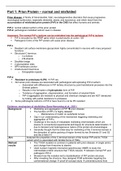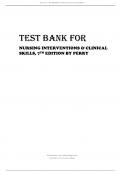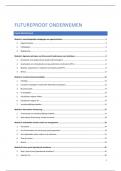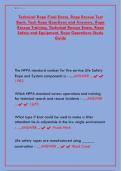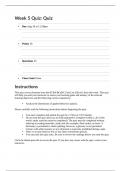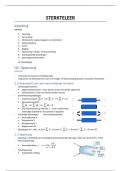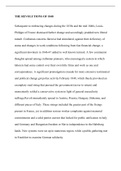Part 1: Prion Protein – normal and misfolded
Prion disease: A family of transmissible, fatal, neurodegenerative disorders that cause progressive
neurological dysfunction, especially dementia, ataxia, and myoclonus, and which result from the
accumulation of misfolded prion protein (PrP) in the CNS that affect humans and animals
PrP-c: normal cellular isoform of the prion protein
PrP-d: pathological misfolded isoform seen in disease
Argument: The normal PrP-c isoform can be misfolded into the pathological PrP-d isoform
PrP is encoded by the PRNP gene which is polymorphic at codon 129
Pathogenic forms of the PrP protein will cause prion disease
PrP-c
Resident cell surface membrane glycoprotein highly concentrated in neurons with many proposed
functions
Structured C terminus
o 3 a-helices
o 2 B-strands
Disulfide bridge
2 glycosylation sites
GPI membrane anchor
Unstructured N-terminus
o Octapeptide repeats
PrP-d
Resistant to proteinase K (PK) PrP-res
All human prion disease are associated with pathological self-replicating PrP-d isoform
o Associated with differences in PrP tertiary structure by post-translational processes into the
B-sheet pattern
o Results in the formation of hydrophobic form of PrP
o Tendency of aggregation, oligomerisation, and formation of amyloid fibrils
o PrP-d aggregates are resistant to physical and chemical changes and are NOT denatured
by boiling with partial resistance to proteases
Some pathological isoforms of PrP-d have found to not be PK resistant
Evidence: mechanism of misfolding (Sanz-Hernandez et al., 2021)
Background Misfolding and aggregation of PrP prion disease
The function of PrP-c is highly debated
o Maintenance of myelin on peripheral nerves
Gap in our understanding of the mechanism triggering misfolding and
aggregation of PrP-c
Challenge in the study of metastable misfolding intermediates which are
elusive to conventional experimental techniques for structural determination
due to transient and heterogeneous nature of the protein structures/stages
Generally thought that the initial step for misfolding of the C-terminal domain is
the disruption of native packing of region formed by two B-strands S1 and S2
and the a-helix H1
Aim Analysed the properties of the C-terminal domain of the human PrP and its T183A
variant which is associated with familial forms of TSEs
Method/ The T183A mutation is common in patients with prion disease single amino
results acid change from threonine to alanine
Used nuclear magnetic resonance spectroscopy (NMR) to study the
intermediate protein structure that T183A induces between normal PrP and
pathogenic PrP-d
Showed how the mutation led to destabilisation of PrP protein structure
After revealing the structure, they designed POM antibodies targeting the
conformational change proof-of-concept study prevented prions from
, transitioning into their pathogenic isoforms by blocking the misfolding
mechanism
Conclusion Possible molecular strategies of inhibiting PrP aggregation into amyloids
Part 2: Pathogenesis of Prion Disease
Point: There are 3 stages/main points to prion disease
1. Misfolding of/ the normal PrP protein
2. Pathogenic characteristics of the misfolded PrP-d isoform
3. Accumulation and spreading of this pathogenic PrP-d isoform
Argument: Conversion of the normal PrP-c to the misfolded PrP-d is responsible for prion disease
Prion disease is associated with the misfolded PrP-d in the CNS of humans and animals
There are 3 ways that the pathogenic PrP-d isoform can be generated
1. Spontaneous conversion of PrP-c to PrP-d (~90%)
o Sporadic forms (sCJD and SFI)
2. Mutation of the PRNP gene (~5-10%) that promoted the misfolded PrP-d isoform
o fCJD, FFI, and GSS
3. Exposure to prions (<1%)
o Acquired forms such as vCJD and iCJD
Evidenc
1. Infectious agent may be protein based (Pattison and Jones, 1967)
a. Procedures that obliterate nucleic acids (i.e., ionising radiation + UV) do not destroy
infectious material (Alper et al., 1992, 1996)
b. Minimal molecular weight to maintain infectivity is too small to be a virus or other type of
microorganism (Alper, 1966)
c. Protein-only hypothesis proposed by Griffith in 1967 but little research done to test this
2. PrP-Sc isolated from infectious material (Bolton et al., 1982)
a. PrP-Sc and infecitivty co-purified and the protein concentration was proportional to the
infectivity titre (Gabizon et al., 1988)
3. Gene encoding PrP identified as PRNP (Oesch et al., 1985; Chesebro et al., 1985)
a. Corresponding mRNA shown to be produce of single host gene expressed mostly in the
brain
b. No significant changes in expression in healthy or infected animals
c. Indicated that prion protein can exist as normal cellular protein (PrP-c) and pathological
isoform (PrP-Sc) (Basler et al., 1986)
d. No chemical differences detected between the two isoforms but there are differences in the
conformations adopted
4. PRNP mutation linked to familial prion disease (Hsiao et al., 1989)
a. Subsequent studies showed that all the familial cases of prion disease are linked to PRNP
b. Expression of mutant Prnp in mice produces transmissible neurodegenerative disorder
similar to prion disease (Sigurdson et al., 2009; Jackson et al., 2009)
5. Prnp-/- mice are resistant to scrapie infection (Bueler et al., 1993) KEY EVIDENCE
a. Do not develop signs of the disease or allow propagation of the infectious agent
6. Conversion of PrP-C to PrP-res is catalysed by pathological protein (Kocisko et al., 1994)
a. Purified PrP-c mixed with stoichiometric amounts of purified PrP-Sc produces low yield of
PrP-res formation under non-physiological conditions
Argument: spontaneous conversion of PrP-c to PrP-d causes prion disease
Argument: a misfolded PrP-d isoform can be formed due to mutations of the PRNP gene
Part 3: The Prion Hypothesis
Stanley B. Prusiner (1982): the scrapie agent was a proteinaceous infectious particle because infectivity
was dependent on protein but resistant to methods known to destroy nucleic acids
- PrP-d is visualised as amyloid fibrils ultrastructurally
Prion disease: A family of transmissible, fatal, neurodegenerative disorders that cause progressive
neurological dysfunction, especially dementia, ataxia, and myoclonus, and which result from the
accumulation of misfolded prion protein (PrP) in the CNS that affect humans and animals
PrP-c: normal cellular isoform of the prion protein
PrP-d: pathological misfolded isoform seen in disease
Argument: The normal PrP-c isoform can be misfolded into the pathological PrP-d isoform
PrP is encoded by the PRNP gene which is polymorphic at codon 129
Pathogenic forms of the PrP protein will cause prion disease
PrP-c
Resident cell surface membrane glycoprotein highly concentrated in neurons with many proposed
functions
Structured C terminus
o 3 a-helices
o 2 B-strands
Disulfide bridge
2 glycosylation sites
GPI membrane anchor
Unstructured N-terminus
o Octapeptide repeats
PrP-d
Resistant to proteinase K (PK) PrP-res
All human prion disease are associated with pathological self-replicating PrP-d isoform
o Associated with differences in PrP tertiary structure by post-translational processes into the
B-sheet pattern
o Results in the formation of hydrophobic form of PrP
o Tendency of aggregation, oligomerisation, and formation of amyloid fibrils
o PrP-d aggregates are resistant to physical and chemical changes and are NOT denatured
by boiling with partial resistance to proteases
Some pathological isoforms of PrP-d have found to not be PK resistant
Evidence: mechanism of misfolding (Sanz-Hernandez et al., 2021)
Background Misfolding and aggregation of PrP prion disease
The function of PrP-c is highly debated
o Maintenance of myelin on peripheral nerves
Gap in our understanding of the mechanism triggering misfolding and
aggregation of PrP-c
Challenge in the study of metastable misfolding intermediates which are
elusive to conventional experimental techniques for structural determination
due to transient and heterogeneous nature of the protein structures/stages
Generally thought that the initial step for misfolding of the C-terminal domain is
the disruption of native packing of region formed by two B-strands S1 and S2
and the a-helix H1
Aim Analysed the properties of the C-terminal domain of the human PrP and its T183A
variant which is associated with familial forms of TSEs
Method/ The T183A mutation is common in patients with prion disease single amino
results acid change from threonine to alanine
Used nuclear magnetic resonance spectroscopy (NMR) to study the
intermediate protein structure that T183A induces between normal PrP and
pathogenic PrP-d
Showed how the mutation led to destabilisation of PrP protein structure
After revealing the structure, they designed POM antibodies targeting the
conformational change proof-of-concept study prevented prions from
, transitioning into their pathogenic isoforms by blocking the misfolding
mechanism
Conclusion Possible molecular strategies of inhibiting PrP aggregation into amyloids
Part 2: Pathogenesis of Prion Disease
Point: There are 3 stages/main points to prion disease
1. Misfolding of/ the normal PrP protein
2. Pathogenic characteristics of the misfolded PrP-d isoform
3. Accumulation and spreading of this pathogenic PrP-d isoform
Argument: Conversion of the normal PrP-c to the misfolded PrP-d is responsible for prion disease
Prion disease is associated with the misfolded PrP-d in the CNS of humans and animals
There are 3 ways that the pathogenic PrP-d isoform can be generated
1. Spontaneous conversion of PrP-c to PrP-d (~90%)
o Sporadic forms (sCJD and SFI)
2. Mutation of the PRNP gene (~5-10%) that promoted the misfolded PrP-d isoform
o fCJD, FFI, and GSS
3. Exposure to prions (<1%)
o Acquired forms such as vCJD and iCJD
Evidenc
1. Infectious agent may be protein based (Pattison and Jones, 1967)
a. Procedures that obliterate nucleic acids (i.e., ionising radiation + UV) do not destroy
infectious material (Alper et al., 1992, 1996)
b. Minimal molecular weight to maintain infectivity is too small to be a virus or other type of
microorganism (Alper, 1966)
c. Protein-only hypothesis proposed by Griffith in 1967 but little research done to test this
2. PrP-Sc isolated from infectious material (Bolton et al., 1982)
a. PrP-Sc and infecitivty co-purified and the protein concentration was proportional to the
infectivity titre (Gabizon et al., 1988)
3. Gene encoding PrP identified as PRNP (Oesch et al., 1985; Chesebro et al., 1985)
a. Corresponding mRNA shown to be produce of single host gene expressed mostly in the
brain
b. No significant changes in expression in healthy or infected animals
c. Indicated that prion protein can exist as normal cellular protein (PrP-c) and pathological
isoform (PrP-Sc) (Basler et al., 1986)
d. No chemical differences detected between the two isoforms but there are differences in the
conformations adopted
4. PRNP mutation linked to familial prion disease (Hsiao et al., 1989)
a. Subsequent studies showed that all the familial cases of prion disease are linked to PRNP
b. Expression of mutant Prnp in mice produces transmissible neurodegenerative disorder
similar to prion disease (Sigurdson et al., 2009; Jackson et al., 2009)
5. Prnp-/- mice are resistant to scrapie infection (Bueler et al., 1993) KEY EVIDENCE
a. Do not develop signs of the disease or allow propagation of the infectious agent
6. Conversion of PrP-C to PrP-res is catalysed by pathological protein (Kocisko et al., 1994)
a. Purified PrP-c mixed with stoichiometric amounts of purified PrP-Sc produces low yield of
PrP-res formation under non-physiological conditions
Argument: spontaneous conversion of PrP-c to PrP-d causes prion disease
Argument: a misfolded PrP-d isoform can be formed due to mutations of the PRNP gene
Part 3: The Prion Hypothesis
Stanley B. Prusiner (1982): the scrapie agent was a proteinaceous infectious particle because infectivity
was dependent on protein but resistant to methods known to destroy nucleic acids
- PrP-d is visualised as amyloid fibrils ultrastructurally

